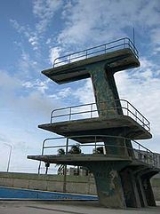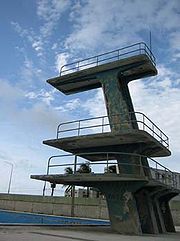
Diving platforms
Encyclopedia
A diving platform or diving tower is a type of structure used for competitive diving
.
 They consist of a vertical rigid "tower" with one or more horizontal platforms extending out over a deep pool of water. In platform diving, the diver jumps from a high stationary surface. The height of the platform(s) - 10 metre/33 feet, 7.5 metre/24.7 feet and 5 metre/16.5 feet - gives the diver enough time to perform the acrobatic
They consist of a vertical rigid "tower" with one or more horizontal platforms extending out over a deep pool of water. In platform diving, the diver jumps from a high stationary surface. The height of the platform(s) - 10 metre/33 feet, 7.5 metre/24.7 feet and 5 metre/16.5 feet - gives the diver enough time to perform the acrobatic
movements of a particular dive. There are addition platforms set at 3 metres/9.84 feet and 1 metre/3.28 feet. These are primarily for practice and building confidence before moving a new diver to the higher levels. Diving platforms for FINA
Sanctioned meets must be at least 6 metres/19.8 feet long and 2 metres/6.6 feet wide. Most platforms are covered by some sort of matting or non-slip surface to prevent athletes from slipping.
All three levels of the platform are used in JO and NCAA competition. Each level offers a distinct degree of difficulty (DD) and therefore could yield different scores for divers.
To reduce the subjectivity of scoring in major meets, panels of five or seven judges are assembled. In the case where five judges are assembled, the highest and lowest scores are tossed and the middle three are summed and multiplied by the DD. In the case where seven judges are assembled, the highest and lowest scores are tossed and the middle five are summed and multiplied by the DD. Accordingly, it is extremely difficult for one judge to manipulate scores.
There is a general misconception about scoring and judging. In serious meets, the absolute score is somewhat meaningless. It is the relative score, not the absolute score that wins meets. Accordingly, good judging implies consistent scoring across the dives. Specifically, if a judge consistently gives low scores for all divers, or consistently gives high scores for the same divers, the judging will yield fair relative results and will cause divers to place in the correct order. However, absolute scores have significance to the individual divers. Besides the obvious instances of setting records, absolute scores are also used for rankings and qualifications for higher level meets.
In competition, divers must submit their lists beforehand, and past a certain deadline (usually when the event is announced shortly before it begins) they cannot change their dives under any circumstances. If they fail to perform the dive announced, even if they physically cannot execute the dive announced, even if they perform a more difficult dive, they will receive a score of zero. Under exceptional circumstances, a re-dive may be granted, but these are exceedingly rare (usually for very young divers just learning how to compete, or if some event outside the diver's control has caused them to be unable to perform).
There are some American meets which will allow changes of the position of the dive even after the dive has been announced immediately before execution, but these are an exception to the rules generally observed internationally.
Generally, NCAA rules allow for dives to be changed while the diver is on the platform, but the diver must request the change directly after the dive is announced. This applies especially in cases where the wrong dive is announced. If the diver pauses during his or her hurdle to ask for a change of dive, it will be declared a balk and the change of dive will not be permitted.
This can sometimes be dangerous.
Diving
Diving is the sport of jumping or falling into water from a platform or springboard, sometimes while performing acrobatics. Diving is an internationally-recognized sport that is part of the Olympic Games. In addition, unstructured and non-competitive diving is a recreational pastime.Diving is one...
.

Acrobatics
Acrobatics is the performance of extraordinary feats of balance, agility and motor coordination. It can be found in many of the performing arts, as well as many sports...
movements of a particular dive. There are addition platforms set at 3 metres/9.84 feet and 1 metre/3.28 feet. These are primarily for practice and building confidence before moving a new diver to the higher levels. Diving platforms for FINA
Fina
Fina may refer to:*Fina, a character in the Skies of Arcadia video game*FINA, the International Swimming Federation*FINA, the North American Forum on Integration...
Sanctioned meets must be at least 6 metres/19.8 feet long and 2 metres/6.6 feet wide. Most platforms are covered by some sort of matting or non-slip surface to prevent athletes from slipping.
All three levels of the platform are used in JO and NCAA competition. Each level offers a distinct degree of difficulty (DD) and therefore could yield different scores for divers.
Scoring the Dive
Ultimately, the judges' scores given on each dive are subjective. However, there are specific rules governing how a dive is supposed to be scored. Usually a score factors three elements of the dive: the approach, the flight, and the entry. The primary factors affecting the scoring are: (1) the platform selected (10-meter, 7.5-meter, or 5-meter), (2) if a hand-stand is required, the length of time and quality of the hold, (3) the height of the diver at the apex of the dive, with extra height resulting in a higher score, (4) the distance of the diver from the diving apparatus throughout the dive (a diver must not be dangerously close, should not be too far away, but should ideally be within 2 foot (0.6096 m) of the platform), (5) the properly defined body position of the diver according to the dive being performed, including pointed toes and feet touching at all times, (6) the proper amounts of rotation and revolution upon completion of the dive and entry into the water, and (7) angle of entry (a diver should enter the water straight, without any angle). Many judges award divers for the amount of splash created by the diver on entry, with less splash resulting in a higher score.To reduce the subjectivity of scoring in major meets, panels of five or seven judges are assembled. In the case where five judges are assembled, the highest and lowest scores are tossed and the middle three are summed and multiplied by the DD. In the case where seven judges are assembled, the highest and lowest scores are tossed and the middle five are summed and multiplied by the DD. Accordingly, it is extremely difficult for one judge to manipulate scores.
There is a general misconception about scoring and judging. In serious meets, the absolute score is somewhat meaningless. It is the relative score, not the absolute score that wins meets. Accordingly, good judging implies consistent scoring across the dives. Specifically, if a judge consistently gives low scores for all divers, or consistently gives high scores for the same divers, the judging will yield fair relative results and will cause divers to place in the correct order. However, absolute scores have significance to the individual divers. Besides the obvious instances of setting records, absolute scores are also used for rankings and qualifications for higher level meets.
Competitive Strategy
To win dive meets, divers create a dive list in advance of the meet. To win the meet the diver must accumulate more points than other divers. Usually simple dives with low DDs will look good to spectators but will not win meets. The competitive diver will attempt the highest DD dives possible with which they can achieve consistent, high scores. If divers are scoring 8 or 9 on most dives, it may be a sign of their extreme skill, or it may be a sign that their dive list is not competitive, and they may lose the meet to a diver with higher DDs and lower scores.In competition, divers must submit their lists beforehand, and past a certain deadline (usually when the event is announced shortly before it begins) they cannot change their dives under any circumstances. If they fail to perform the dive announced, even if they physically cannot execute the dive announced, even if they perform a more difficult dive, they will receive a score of zero. Under exceptional circumstances, a re-dive may be granted, but these are exceedingly rare (usually for very young divers just learning how to compete, or if some event outside the diver's control has caused them to be unable to perform).
There are some American meets which will allow changes of the position of the dive even after the dive has been announced immediately before execution, but these are an exception to the rules generally observed internationally.
Generally, NCAA rules allow for dives to be changed while the diver is on the platform, but the diver must request the change directly after the dive is announced. This applies especially in cases where the wrong dive is announced. If the diver pauses during his or her hurdle to ask for a change of dive, it will be declared a balk and the change of dive will not be permitted.
This can sometimes be dangerous.

